One of the most efficient cladding systems in construction is rainscreen cladding. Rainscreen cladding is a building solution that fits perfectly into today’s sustainable trends in architecture and is relatively easy to install. A rainscreen is a detail on the exterior of a wall that acts as an outer skin to protect the building from rain and to provide a layer of insulation.
How does a rainscreen cladding system work?
A rainscreen cladding system is made with an insulation layer, a bearing wall, and a cladding material that is adhered to a building with a supporting structure. The supporting structure creates an air cavity between the cladding material and the load-bearing wall to permit continuous ventilation.
Usually, there is a layer of insulation between the cladding and the load-bearing wall, but this depends on the building. Sometimes, the insulating material is fixed inside the building or the load-bearing wall itself provides insulating properties.
What are the benefits of rainscreen cladding?
A poorly made external brick cladding installation or internal brick cladding structure can lead to significant energy losses, but a rainscreen cladding system can preserve energy due to its exterior air cavity. By combining an exterior installation system with a rainscreen cladding system, a building is provided with both acoustic and thermal installation.
The air cavity in a rainscreen cladding system also keeps the temperature in the building construction envelope at a more stable level, which can prevent structural issues such as cracks from forming. As there is a reduced risk of extreme temperature changes in the structure, it is less likely to be damaged by contraction or expansion movements.
For brick cladding services in London that you can depend on, get in touch with RGB Facades today.

